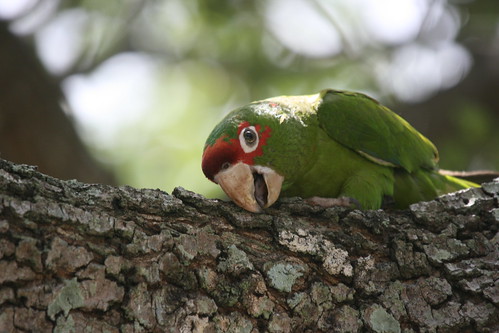 Mitred Conure taking a closer look at Miami Springs, FL
Mitred Conure taking a closer look at Miami Springs, FL
PARROTS could hold the key to improving human eyesight, according to University of WA professor David Hunt.
Prof Hunt, from the School of Animal Biology, said parrots, unlike humans, could look at ultraviolet light without sustaining eye damage.
He said the mechanisms they used to deal with longer-term exposure to UV could offer valuable insight into human eyesight.
“Since these birds have a lifespan similar to that of humans – there is anecdotal evidence that Winston Churchill’s African Grey lived to the ripe old age of 104 (Ed. This has since been shown to be false) – it raises the question of how their eyes cope with long-term UV exposure,” he said.
“We humans wear sunglasses to protect our eyes from UV rays but this is not a luxury that is available to a parrot.
“The ability to see into the UV means that the world is coloured differently to a parrot. What do they use UV vision for? It may be useful for foraging for food or for selecting a mate.”
Earlier this month, Prof Hunt and his team published their research, which used the DNA of parrots including the blue and gold macaw, galah, rosella and kea.
From the samples, taken from new (blood) feathers pulled from the birds, they were able to obtain the gene sequence of the bird’s visual pigment. (Vision is dependent on the visual pigments).
“The ability to see into the UV is not uncommon in animals, but has been lost by most placental mammals and some marsupials,” Prof Hunt said.
“Among the birds, UV vision is less common. Evolutionary evidence indicates that it was lost at the base of the avian lineage and has been ‘re-invented’ in a few groups of birds – mainly the passerine or perching birds (canaries, finches etc) and the psittacines or parrots.” Prof Hunt’s research began in 2005 and was completed last year.
“I am fascinated by the way different species see the world and how their visual systems have adapted to seeing in a range of different habitats, especially where light is very limiting as in the deep ocean,” he said.